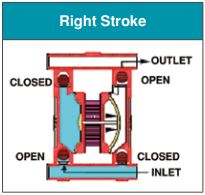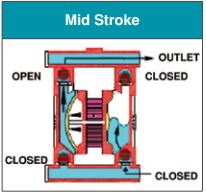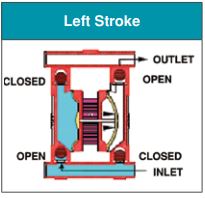RUBY AIR DIAPHRAGM PUMPS
Ruby Air Diaphragm Pumps - How It Works?
The Ruby diaphragm pump is an air-operated, positive displacement, self-priming pump. These drawings show flow pattern through the pump upon it’s initial stroke. It is assumed the pump has no fluid in it, prior to it’s nitial stroke.
 p>FIGURE 1
p>FIGURE 1
- The air valve directs pressurized air to the back side of diaphragm A.
- The compressed air is applied directly to the liquid column separated by elastomeric diaphragms.
- The diaphragm acts as a separation membrane between the compressed air and liquid, balancing the load and removing mechanical stress from the diaphragm.
- The compressed air moves the diaphragm away from the center block of the pump.
- The opposite diaphragm is pulled in by the shaſt connected to the pressurized diaphragm.
- Diaphragm B is on it’s suction stroke; air behind the diaphragm has been forced out to the atmosphere through the exhaust port of the pump.
- The movement of diaphragm B toward the center block of the pump creates a vaccuum within chamber B.
- Atmospheric pressure forces fluid into the inlet manifold forcing the inlet valve ball off its seat.
- Liquid is free to move past the inlet valve ball and fill the liquid chamber (see shaded area).

FIGURE 2
- When the pressurized diaphragm, diaphragm A, reaches the limit of it’s discharge stroke, the air valve redirects ressurized air to the back side of diaphragm B.
- The pressurized air forces diaphragm B away from the center block while pulling diaphragm A to the enter block.. Diaphragm B is now on its discharge stroke.
- Diaphragm B forces the inlet valve ball onto its seat due to the hydraulic forces developed in the liquid chamber and manifold of the pump.
- These same hydraulic forces liſt the discharge valve ball off it’s seat, while the opposite discharge valve ball is forced onto it’s seat, forcing fluid to flow through the pump discharge
- The movement of diaphragm A toward the center block of the pump creates a vaccuum within liquid chamber A.
- Atmospheric pressure forces fluid into the inlet manifold of the pump. The inlet valve ball is forced off it’s seat allowing the fluid being pumped to fill the liquid chamber.

FIGURE 3
- At completion of the stroke, the air valve again redirects air to the back side of diaphragm A, which starts diaphragm B on its exhaust stroke.
- As the pump reaches it’s original starting point, each diaphragm has gone through one exhaust and one discharge stroke
- This constitutes one complete pumping cycle.
- The pump may take several cycles to completely prime depending on the conditions of the application

FOLLOW US ON FACEBOOK!
Be fan of our official Facebook fan page and development of the first to get your news!
Contents of Professional Service Package:
- Plate supply for every brand and model.
- Gasket supply for every brand and model.
- Revision and cleaning of plate heat exchanger.
- Fast and detailed cleaning of heat exchanger plates.
- Cleaning heat exchanger plates with special chemicals.
- Production and supply of every type of nut and pin.
- Delivery of heat exchanger operating like it is new.
- 7 days 24 hours service opportunity.














































